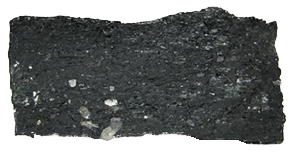![]()
![]()
Throughout the Black Rock area in Nevada one finds every conceivable rock you can think of. Just about all of us have no idea what we are looking at. Our rock collecting is picking up "monkey rocks', those shiny or neat looking peices everywhere. In reality we come across all sorts of interesting things we actually take for granite -granted. This glossary defines many of the rocks we find with accurate descriptions and sometimes photos. Most of these rocks have crystal formations associated with them; which we do not cover. It is not intended to be a Geology Lesson.
A-C • D-F • G-I • J-L • M-O • P-R • S-U • V-X • Y-Z
GARNET - is the name used for a large group of rock-forming minerals. These minerals share a common crystal structure and a generalized chemical composition. These minerals are found throughout the world in metamorphic, igneous, and sedimentary rocks. Most garnet found near Earth's surface forms when a sedimentary rock with a high aluminum content, such as shale, is subjected to heat and pressure intense. enough to produce schist or gneiss. Garnet is also found in the rocks of contact metamorphism, subsurface magma chambers, lava flows, deep-source volcanic eruptions, and the soils and sediments formed when garnet-bearing rocks are weathered and eroded. Garnet species are found in many colors including red, orange, yellow, green, purple, brown, blue, black, pink, and colorless, with reddish shades most common.Garnet species' light transmission properties can range from the gemstone-quality transparent specimens to the opaque varieties used for industrial purposes as abrasives. The mineral's luster is categorized as vitreous (glass-like) or resinous (amber-like). |
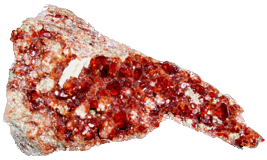 |
|
GOLD - in its natural mineral form almost always has traces of silver, and may also contain traces of copper and iron. A Gold nugget is usually 70 to 95 percent gold, and the remainder mostly silver. The color of pure Gold is bright golden yellow, but the greater the silver content, the whiter its color is. Much of the gold mined is actually from gold ore rather then actual Gold specimens. The ore is often brown, iron-stained rock or massive white Quartz, and usually contains only minute traces of gold. To extract the gold, the ore is crushed, then the gold is separated from the ore by various methods.Gold nuggets, a popular form of Gold with collectors, are formed when erosion causes a large piece of Gold to separate from its mother rock, and then gets carried into a stream or river. The flowing water tumbles the Gold, giving it its distinct rounded shape. The Gold eventually settles at the bottom of the water, and due to its heaviness remains there. Other nuggets also get caught in the same area, forming a placer deposit. In addition, it can be easily separated from other substances due to the weight differences. Gold is also the most malleable and ductile substance known. |
 |
|
GRANITE - is a common type of felsic intrusive igneous rock that is granular and phaneritic in texture. Granites can be predominantly white, pink, or gray in color, depending on their mineralogy. The word "granite" comes from the Latin granum, a grain, in reference to the coarse-grained structure. By definition, granite is an igneous rock with at least 20% quartz and up to 65% alkali feldspar by volume. The term "granitic" means granite-like and is applied to granite and a group of intrusive igneous rocks with similar textures and slight variations in composition and origin. These rocks mainly consist of feldspar, quartz, mica, and amphibole minerals, which form an interlocking, somewhat equigranular matrix of feldspar and quartz with scattered darker biotite mica and amphibole (often hornblende) peppering the lighter color minerals. Occasionally some individual crystals (phenocrysts) are larger than the groundmass, in which case the texture is known as porphyritic. Granite differs from granodiorite in that at least 35% of the feldspar in granite is alkali feldspar as opposed to plagioclase; it is the potassium feldspar that gives many granites a distinctive pink color. Granite is nearly always massive (lacking any internal structures), hard and tough, and therefore it has gained widespread use throughout human history, and more recently as a construction stone. |
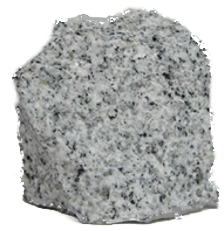 |
|
GRANODIORITE - is a phaneritic texture intrusive igneous rock similar to granite, but containing more plagioclase feldspar than orthoclase feldspar. Granodiorite has a greater than 20% quartz by volume, and between 65% to 90% of the feldspar is plagioclase.
Granodiorite is felsic to intermediate in composition. It's the intrusive igneous equivalent of the extrusive igneous dacite. It contains a large amount of sodium (Na) and calcium (Ca) rich plagioclase, potassium feldspar, quartz, and minor amounts of muscovite mica as the lighter colored mineral components. Biotite and amphiboles often in the form of hornblende are more abundant in granodiorite than in granite, giving it a more distinct two-toned or overall darker appearance. Granodiorite will in most cases be darker than Granite |
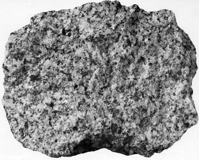 |
|
GYPSUM - is a common mineral, with thick and extensive evaporite beds in association with sedimentary rocks. It is a major rock forming mineral that produces massive beds, usually from precipitation out of highly saline waters., as well as in hot springs, from volcanic vapors, and sulfate solutions in veins. Hydrothermal anhydrite in veins is commonly hydrated to gypsum by groundwater in near-surface exposures. It is often associated with the minerals halite and sulfur. Pure gypsum is white, but other substances found as impurities may give a wide range of colors to local deposits. Because gypsum dissolves over time in water, gypsum is rarely found in the form of sand. Crystals of gypsum can be extremely colorless and transparent, making a strong contrast to the most common usage in drywall. The crystals can also be quite large. Gypsum is a natural insulator, feeling warm to the touch when compared to a more ordinary rock or quartz crystal. Sheets of clear crystals can be easily peeled from a a larger specimen. |
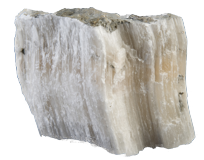 |
|
|
||
|
||
